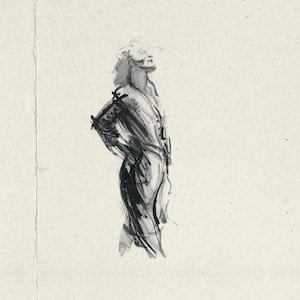
Polly Paulusma – Invisible Music
Wild Sound / One Little Independent Records – 23 April 2021
Well, here’s something a bit different. Having made her critically acclaimed debut in 2004, Polly Paulusma has gone on to release a further six studio albums, play support to the likes of Bob Dylan, Marianne Faithful and Coldplay, found her own Wild Sound label and tour in partnership with Annie Dressner. She’s also just completed a PhD on Angela Carter’s folk singing, from whence derives this new album which carries the subtitle ‘folk songs that influenced Angela Carter’. The late novelist, who specialised in feminist, magical realism storytelling, is best known as the author of The Bloody Chamber, an anthology of ten stories that reworked traditional folk or fairytales, among them The Company of Wolves. Perhaps less well known is that she started her career as a folk singer in 60s Bristol, co-founding her own club, and published an essay titled Now Is The Time For Singing which explored the cultural importance of folk songs.
Paulusma’s album draws on that background to celebrate Carter’s musicality and the songs that influenced her writings, the album comprising nine songs, followed by readings of relevant extracts from Carter’s writings by variously Paulusma, Kirsty Logan and Kathryn Williams. It opens with one such, Paulusma reading about a man playing air violin (which inspired the album’s title) from the 1968 novel Several Perceptions before violin introduces and anchors The Maid And The Palmer, a tale of a young woman who has nine incestuous children by variously her father, uncle and brother, murdering them all and burying the bodies around the homestead. Incest – especially intergenerational – is a strong theme in Carter’s stories, which leads then to an extract from the short story The Executioner’s Beautiful Daughter.
Cross-dressing is a familiar occurrence on folk songs, women often masquerading as sailors or soldiers, and the ballad Jack Munro was among several that fed into the figure of the mother in The Bloody Chamber (the extract read by Williams), to which end the jaunty version of the song here arms Jack with a pistol rather than a broadsword.
Returning to incest, this time between siblings, sung unaccompanied, the murder ballad Lucy Wan (sometimes Lizzie Wan), wherein the brother knocks up his sister then kills her before fleeing to sea, used to be a part of Carter’s folk club repertoire and the tale subsequently filtered into The Magic Toyshop, Penetrating To The Heart of the Forest and John Ford’s ‘Tis Pity She’s A Whore’, an extract from which is read by Logan.
It’s back then to bold and ballsy women for the six-minute plus lively strum Lady Isabel & The Elf Knight, the airy delivery belying the narrative (a young woman who elopes with the knight who’s promised to marry her and kills him when he tries to rob and murder her), Carter noting how the ballad was adapted from her story The Erl King (extract read by Williams), from The Bloody Chamber, Paulusma paying homage by having the heroine strangle her demon lover with his own hair as opposed to stabbing him.
The same story, the extract this time by Paulusma, also drew on another murder ballad, The Banks Of Red Roses, again sung a capella, here the false lover luring the maiden to her doom by charming her with his flute playing, although in the story the victim, knowing how devious men are, escapes her intended fate.
Along with shapeshifters, sentient plants are another recurring folk tale them, perhaps the most famous being the rose and briar of Barbary Allen, a song Carter had explored in her unpublished dissertation on the connection between folk song and medieval poetry, the sweetly sung, sparse and musically melancholic fiddle, double bass (by John Parker) and mandolin toned interpretation here followed by Logan’s extract from The Lady Of The House Of Love with its theme of frustrated love.
A third unaccompanied number, this time involving magical castle, arrives with the flowingly lovely The Streams Of Lovely Nancy, a song Carter also wrote about in her undergraduate dissertation and which Paulusma proposes drove the imagery in The Bloody Chamber as illustrated in the extract read by Williams.
The first of the final two songs, the classic Reynardine, was a favourite of Carter, specifically as sung by A.L. Lloyd, to whom she dedicated her Virago Book Of Fairy Tales, the version of the vulpine villain here taken from Lloyd’s second recording of the song that changes shining eyes to shining teeth. Carter drew on the song for the character of Honeybuzzard in her debut novel Shadow Dance, the extract read here by Logan.
The second, The Flower Of Sweet Strabane, is actually an Irish song Carter herself performed, unaccompanied as on this version, in 1967 at the Cheltenham Folk Club, modelled on the style of Paddy Tunney, the album closing with Paulusma’s reading from Reflections, a celebration of the power of the singing voice to go beyond ordinary language, the short story itself inspired by the cover of Anne Briggs eponymous 1971 album. Released as a hardback booklet with pen and pencil sketch illustrations by Christine Molan, this is both a terrific traditional folk album and a fascinating insight into Carter’s creative process and her own pretty much unknown involvement in the folk scene, one which will surely further expand Paulusma’s reputation and bring Carter’s writings to a whole new audience.
Pre-save/Buy: https://pollypaulusma.lnk.to/LIEK
Photo Credit: Annie Dressner

